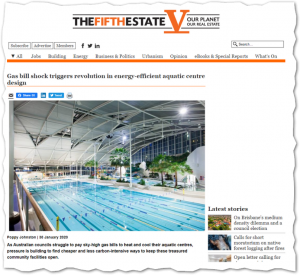Public swimming pools: a niche type of building but important community fixtures. They are also invariably shocking gluttons for energy thanks to stupid design (or stupid decisions by those commissioning them, who have valued form and overlooked function).
As I read this, all I could think about was how the ‘standard approach’ to designing buildings—even big, flash public ones—is simply not fit for purpose. A short-sighted approach makes our councils in New Zealand, and according to this article, the ones in Australia too, vulnerable to energy cost increases and locks in high CO2 emissions. Changing from natural gas to electric heat pumps is a good post-build fix, but these buildings could have been designed to consume half the energy it takes to warm and ventilate them.
I was a bit disappointed to see the article spend so much time discussing heat pumps and batteries, but at least it mentioned the possibility of designing them right in the first place, even if near the end:
“A tighter building envelope will also require a smaller capacity heat pump, meaning that an optimised facility will make a heat pump look more attractive upfront. Although it’s possible to retrofit heat pumps into aquatic centres, the best results undoubtedly come from a facility designed for high thermal performance.”
The UK’s first Passive House swimming pool is currently being developed by Exeter City Council. The scheme’s utility costs are predicted to be around £20/m2/year, which compares favourably to the typical utility costs for a conventional leisure centre of £57/m2/year. This amounts to a savings of $400,000 NZD per year.
I spoke to Emma Osmundsen (managing director of Exeter City Living, the development arm of the Exeter City Council) when she was in Wellington and she told me they were able to nearly double the size of the leisure pool centre for the same annual cost (including borrowing) because the utility savings lowered the ongoing costs so drastically. We didn’t speak about decarbonisation or being safe from natural gas prices tripling overnight, but their choice to build for performance would obviously mitigate those issues too.
Which council in New Zealand will be the first to get on board with specifying radically more efficient public buildings? The Queenstown Lakes District Council has committed to a Passive House build for a community hall in Luggate, but let’s see some leadership around niche public facilities like pools that have very high ongoing energy needs.
—01 Feb 2020
